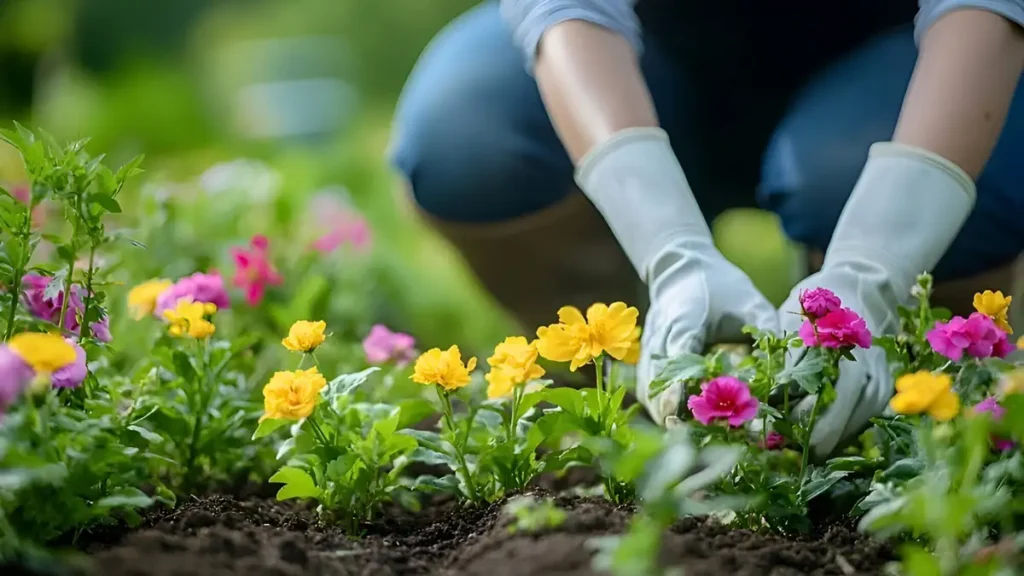Flowers add vitality, color, and scent to any landscape, but growing lush, vivid flowers requires more than just water and sunlight. The appropriate fertilizer is critical for healthy development, strong roots, and long-lasting blooms. Flowers grow when given the proper nutrients, resulting in bright hues, stronger stems, and longer blooming periods. Choosing the best flower fertilizer has a huge impact on plant health and growth. In this post, we’ll look at the finest fertilizers for flowers, their benefits, and how to use them properly.
Learn how to select a flower fertilizer:
When selecting a flower fertilizer, think about your plants’ demands. The three main plant nutrients—nitrogen (N), phosphorus (P), and potassium (K)—are all present in an all-purpose flower fertilizer. Look for a balanced fertilizer (such as 10-10-10) for overall growth or a phosphorus-rich fertilizer (such as 5-10-5) to enhance blooming. Organic choices, such as compost or fish emulsion, increase soil health, but synthetic fertilizers deliver nutrients quickly. Slow-release fertilizers provide long-term benefits, but liquid fertilizers produce quick results. To avoid overfeeding, always check the label for key nutrients such as nitrogen (N), phosphorus (P), and potassium (K) and apply them at the appropriate rates.
When to use flower fertilizer?
The best time to apply flower fertilizer depends on the plant’s growth stage. Fertilize early spring for strong roots and healthy foliage, and use phosphorus-rich fertilizer during flowering. Feed perennials and annuals regularly, avoid late fall or winter, and follow the recommended feeding schedule to avoid over-fertilization.
How to use flower fertilizer effectively:
To optimize effectiveness, fertilizers should be applied during the appropriate growth phases. Fertilize in early spring, before blossoming, and continue throughout the growing season.
Overfertilization can harm plants. To avoid nutrient burn, always follow the application directions provided by the manufacturer.
Watering ensures that nutrients are uniformly distributed in the soil, allowing plant roots to absorb them efficiently.
Mulching with organic materials such as compost or wood chips conserves moisture and improves soil quality, increasing fertilizer efficiency.
Types of flower fertilizer:
Fertilizers are available in a variety of formulations to suit different flowering plants and soil conditions. Understanding their distinctions will allow you to make an informed decision.
1. Granular fertilizers
Granular fertilizers come in two types: quick-release and slow-release. Slow-release fertilizers decompose over time, ensuring consistent nutrient flow, while quick-release fertilizers provide immediate nutrients but may require frequent application.
2. Organic flower fertilizer
Organic fertilizers such as compost, manure, and bone meal improve soil structure and microbial activity, supporting stronger plants in the long run, and include phosphorus for flowering.
In addition to improving soil tilth, organic fertilizers—which come from both living and non-living sources—give flowers vital nutrients. They boost immune systems, don’t burn plants, are non-toxic to wildlife and beneficial insects, and stay active in the soil for long periods. They are more expensive, have fewer formulas, and some pets like the taste. Severe nutritional deficits cannot be solved with organic fertilizers.
3. Liquid flower fertilizer
Liquid fertilizer is easily absorbed by the roots and leaves. They are great for quick-acting nutrients and should be administered monthly or biweekly for optimal results. Organic liquid fertilizers such as seaweed extract and fish emulsion are ideal for natural plant growth.
4. Homemade flower fertilizer
Homemade flower fertilizer is a natural and inexpensive approach to nourishing plants. Banana peels provide potassium, coffee grounds include nitrogen, and eggshells contain calcium. Compost tea and diluted fish tank water both contain critical nutrients. A simple DIY combination can be produced by combining vegetable scraps, Epsom salt, and molasses for a balanced boost. Organic fertilizers create vigorous, vivid blooms while reducing the need for harsh chemicals. Always use in moderation to avoid nutrient imbalances.
Sprinkle a little amount of homemade fertilizer around the base of your plants and then water them.
The ideal flower fertilizer for a particular plant:
Flowers demand different nutrients. Here are some of the most effective fertilizers for popular flowering plants:
1. Rose flower fertilizer
Roses require high phosphorus fertilizers for strong blooms, such as Espoma Rose-Tone (4-3-2) and Miracle-Gro Rose Plant Food (18-24-16), for steady sustenance and increased bloom development.
2. Orchid flower fertilizer
Orchid growth is enhanced by using essential micronutrients and balanced fertilizers like Better-Gro Orchid Plus and MSU Orchid Fertilizer for strong roots and vibrant blooms.
3. Lilies
Lilies require potassium-rich fertilizers like Bulb-Tone and Joe’s Organics Bulb Fertilizer for robust stems and abundant blooms, with slow release and deep root development.
4. Petunias
Petunias require high phosphorus fertilizers like Miracle-Gro Bloom Booster (15-30-15) and Jack’s Classic Petunia Feed (20-6-22) for continued blooming.
Conclusion:
Choosing the best flower fertilizer leads to larger, brighter flowers and healthier plants. Whether you prefer organic or inorganic fertilizers, using proper fertilization practices will increase bloom production and durability. Your garden will bloom with magnificent, bright blossoms all season if the appropriate nutrients are applied at the right time.
Certainly! If you’d like to learn more, please consider following our WhatsApp Channel, Facebook, Instagram, YouTube, Twitter, and Pinterest.
A frequently asked questions:
Q1: What is the best natural fertilizer for flowers?
A1: The finest natural fertilizers for flowers are compost, which nourishes the soil with organic content, and banana peels, which give potassium for vigorous blooms. Other excellent choices are fish emulsion for balanced nutrition and Epsom salt to increase magnesium, which improves floral color and growth.
Q2: What is the best fertilizer for the flowering stage?
A2: To stimulate strong flowers throughout the flowering stage, use a phosphorus-rich fertilizer, such as a 5-10-5 or 10-30-10 combination. Organic solutions such as bone meal and banana peel tea promote good flower development organically.

